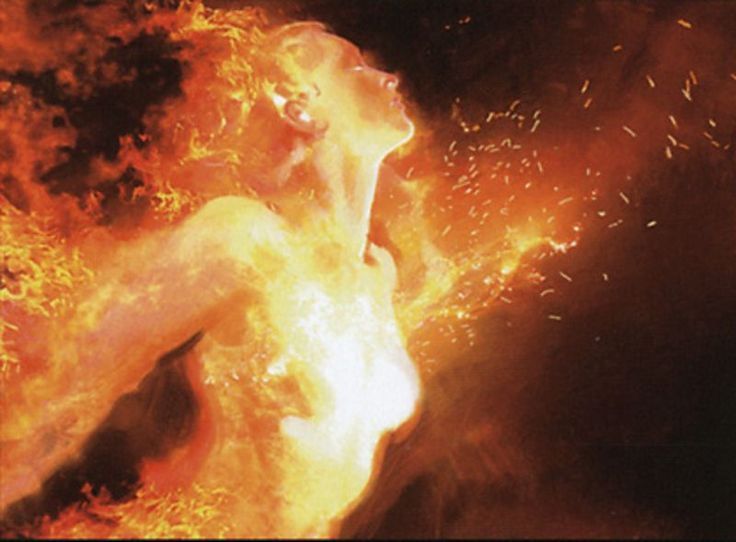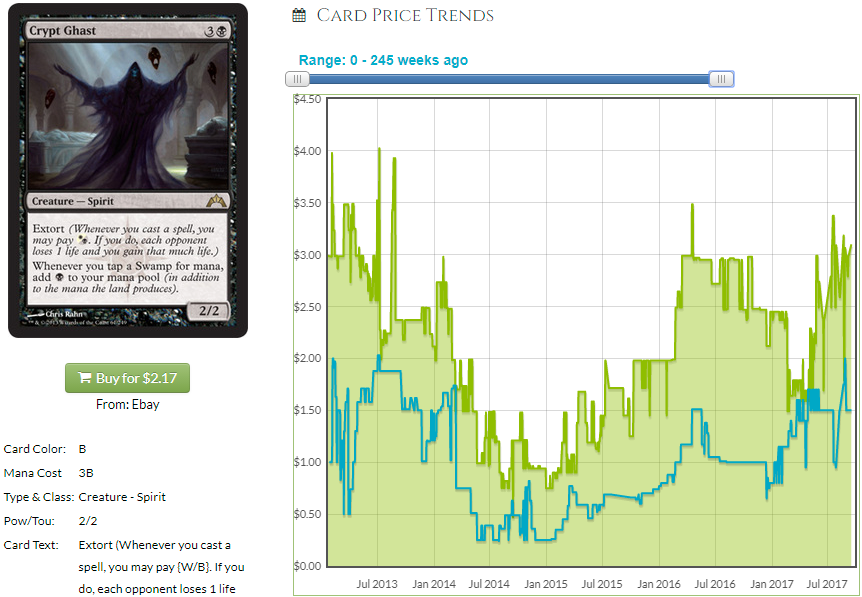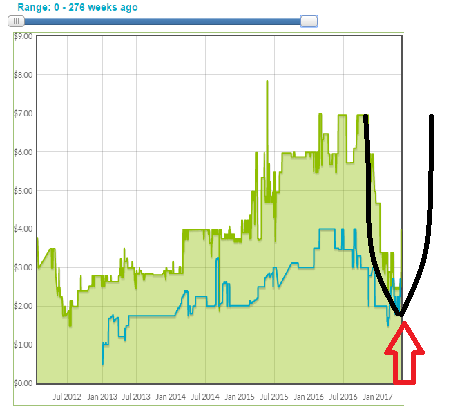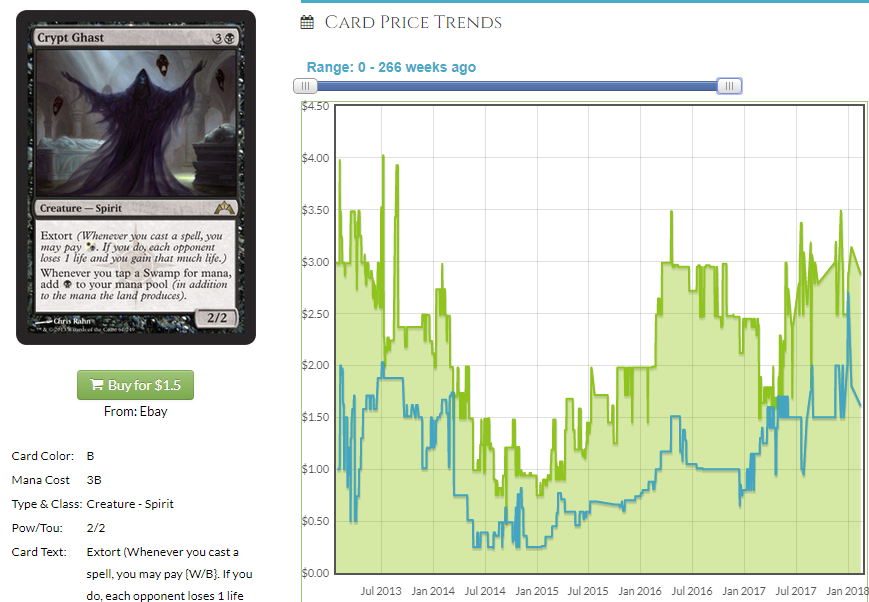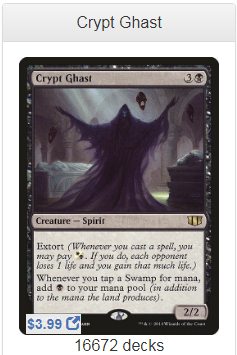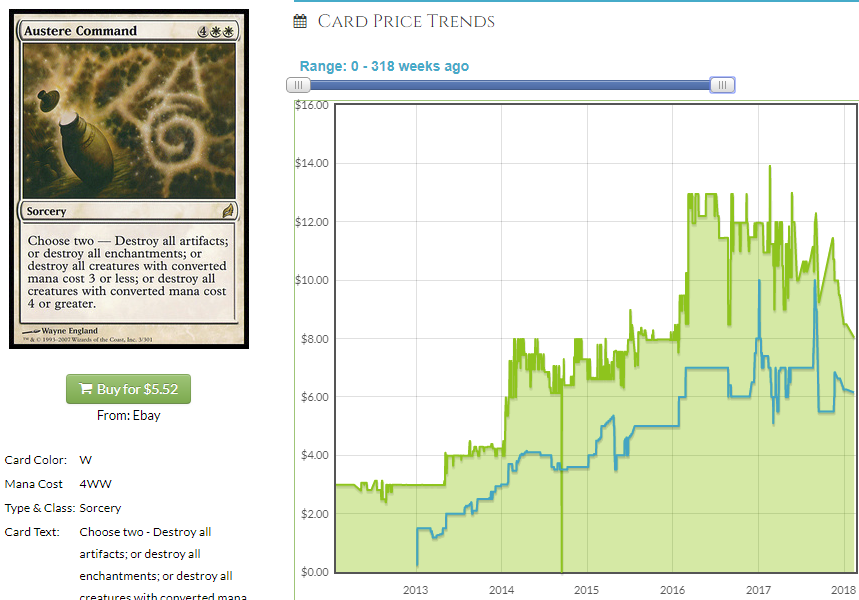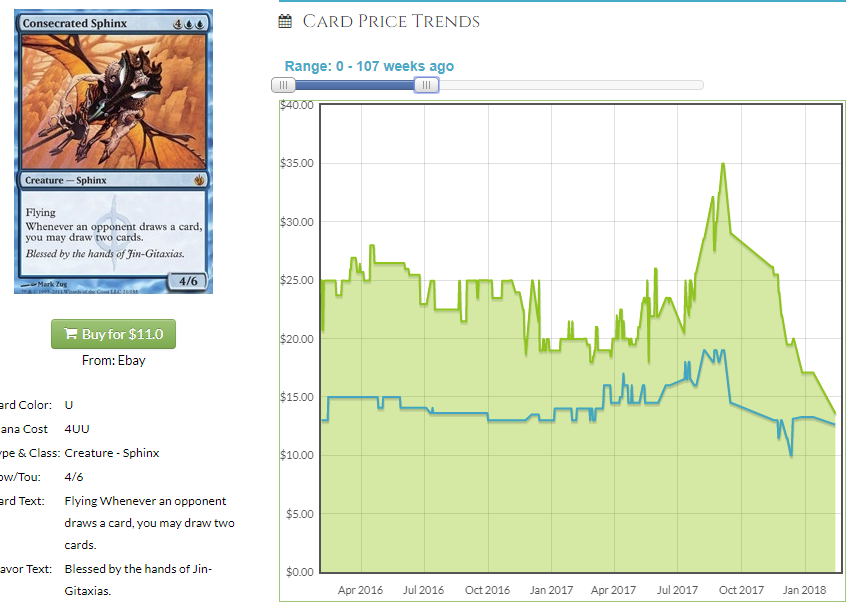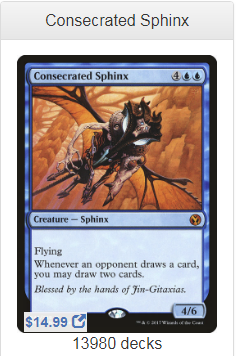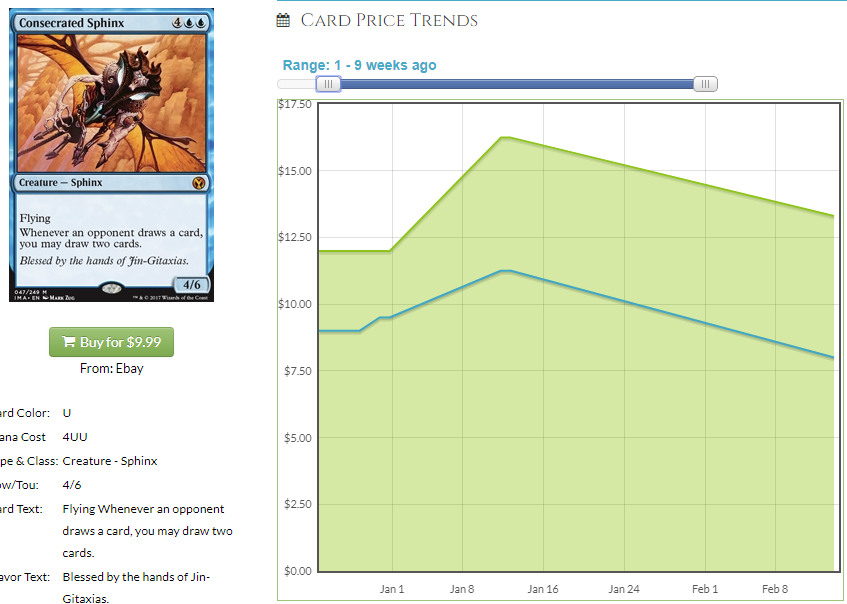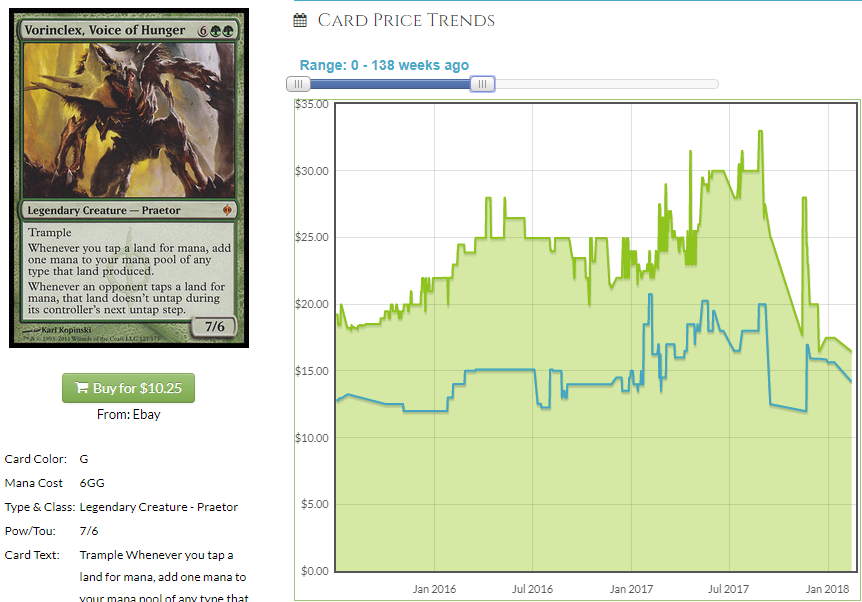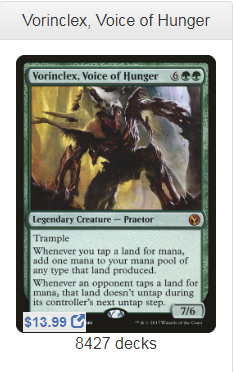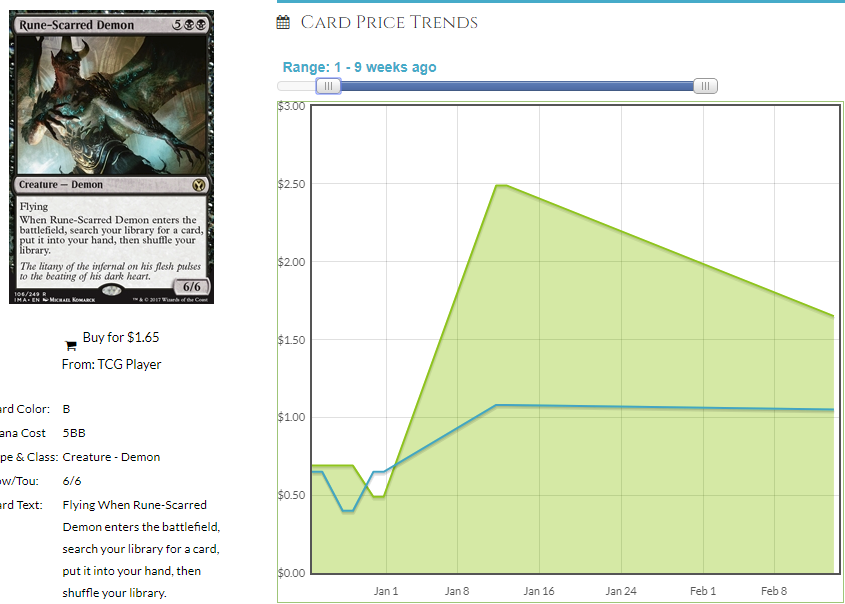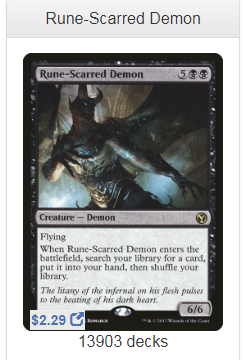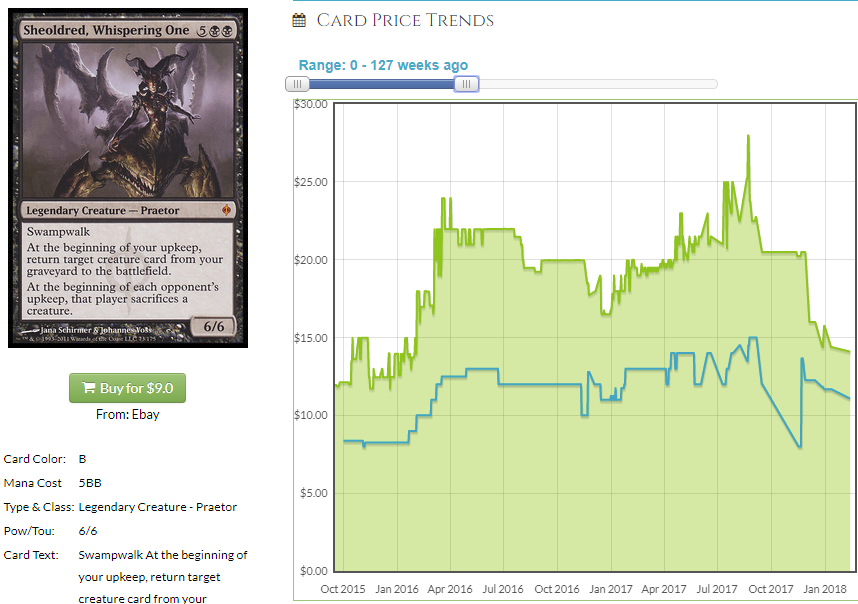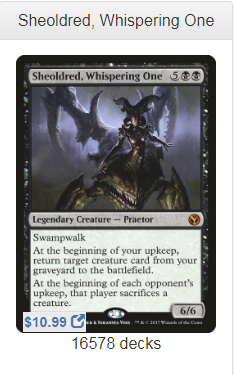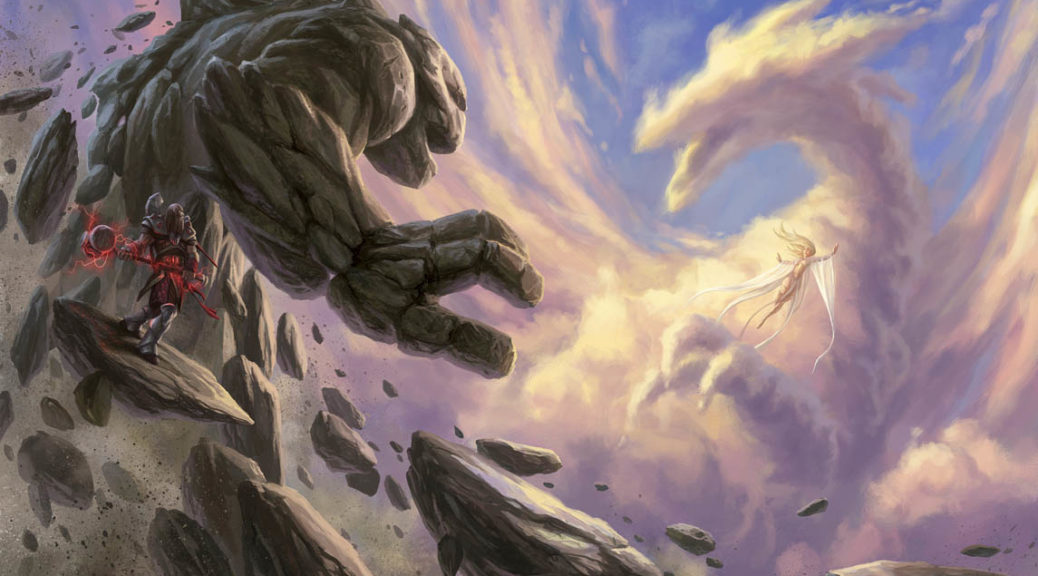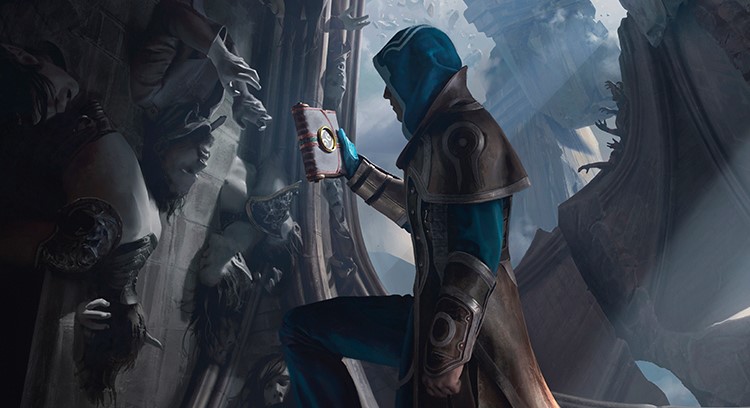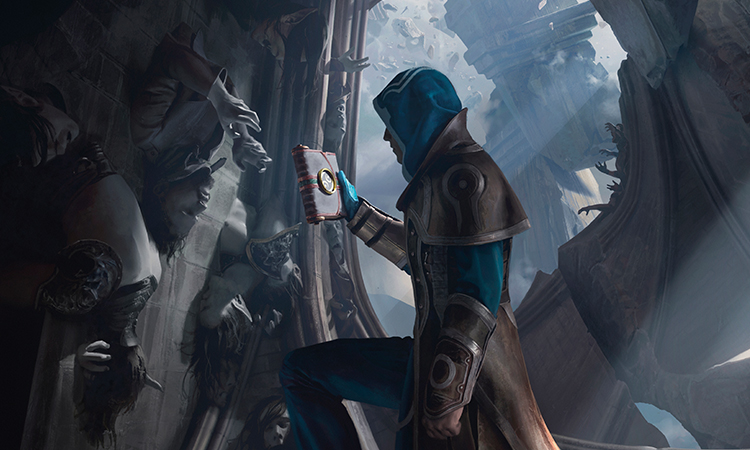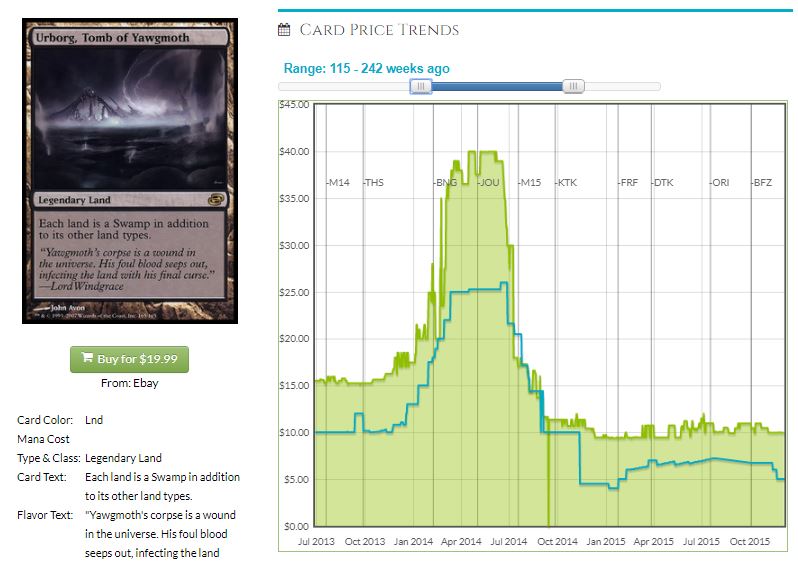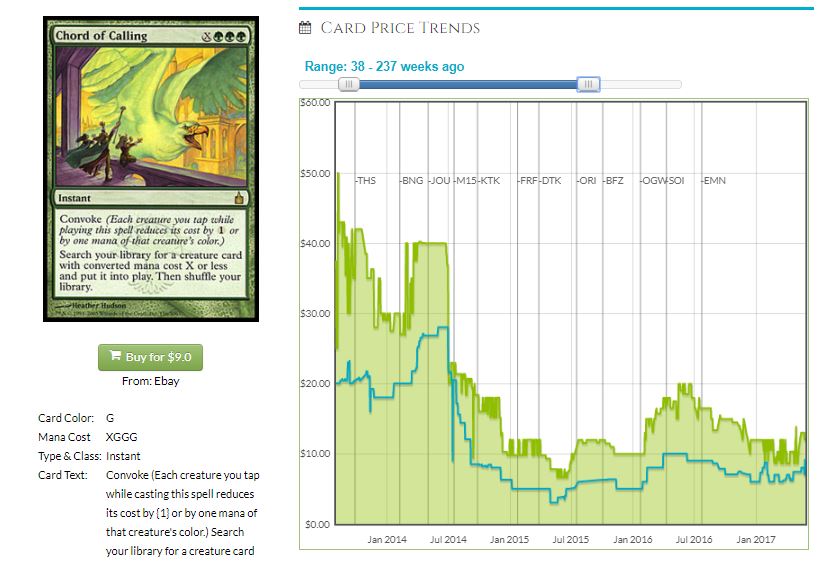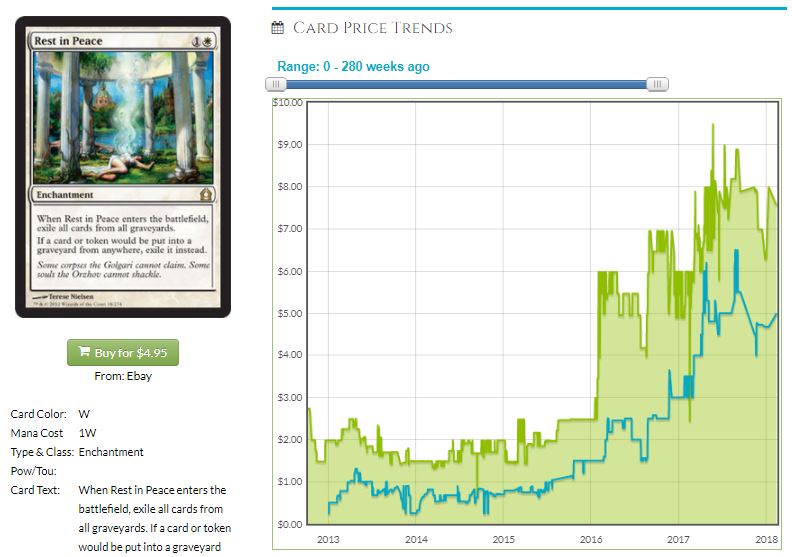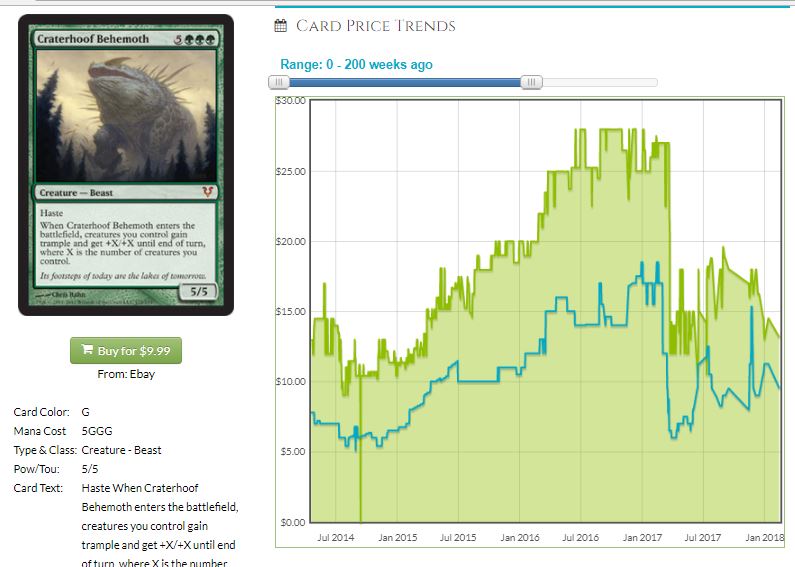I keep harping on the same concepts in this series and that’s because some methods are tried and true and until something changes substantially, they’re what make me money and I love to pass those ideas on to my readers. I’ll go over this one again because I think it bears repeating so everyone from the long-term reader to the first-time reader knows what I’m talking about. Namely, I want to talk about graph shapes; the U and the reverse-J.
GRAAAAAAPHS
If a card is reprinted and its price never recovers, you’ll see a really sad graph shape. It peaks then declines to a valley and it’s so depressing that I am not even going to try and find an example and post it here. It’s like the stuff in the gore subreddit – no one really wants to see that. Instead, let’s talk about a happier scenario – a price declines after a reprint but Mr. Organic Demand comes along and says “Turn that frown upside down” and you’re on the maglev bullet train to money town, baby, where the money grows on money trees and you can pay someone to harvest the money with all of the money you’re making. That looks like this.
So if you saw the rebound coming and bought in at the floor, you’re feeling good. The rebound was predictable if you look at EDH demand at all and understand which cards are likely to rebound based on the amalgam of all of their factors such as how many decks the card is in, when it was first printed, the likelihood of another reprinting coming along and pantsing it, etc. However, as a financier, telling you that Crypt Ghast must be a good card because it was $3 then it was $1 then it was $3 again is pretty useless information unless I think it will got to $8, which I don’t since it was never $8 when the supply was lower and the demand was the same. U-shaped graphs are neat but they can’t make us much money since the price has already recovered. You want the first half of that U shape. You want what I call the reverse-J shape, because our language doesn’t have a letter that looks like the first half of a U.
I use this graphic every time but it illustrates how much money can be made if the card recovers to its pre-dip price. So why do I bring all of this up? And what does the title of the article refer to?
I’m So Glad I Pretended You Asked
A long time ago when I started writing about EDH finance full-time, I thought about how to make money on EDH cards and I decided that when new cards were printed, trying to guess their price was less relevant than looking at the archetypes they were likely to enable and speculating on those older cards. Supply would be lower, upside would be higher since the demand wouldn’t be as easily back-filled with copies at the same price making it spike quickly before anyone could react and every card in the deck would go up – theoretically, a rising tide would lift all boats. Well, today we’re all about Low Tide – the first half of the U. We’re going reverse-J hunting and there is a set that came out recently that is going to be just lousy with those sexy shapes. I think the cards in a certain set are at their floor and we’re going to look at EDH demand to see how likely a recovery is and how much money I think you can make if you buy now. Forget dinosaurs and pirates, let’s think about Benjamins.
Iconic Recovery
Iconic Masters reprinted a ton of sexy EDH cards and I think a lot of them are going to recover. How do we determine the likelihood of recovery? I’m not going to address every factor, but I will do three things.
- I arbitrarily picked Crypt Ghast because that recovered nicely. I’m going to see how many decks on EDHREC have Crypt Ghast in them and then I am going to compare that number to the number of decks the cards in Iconic Masters are in. If it sounds really simple, it’s because it is. Also, almost no one does this sort of analysis so maybe just thank me for doing it for you even though it’s easy and also reminding you to do it because that’s the actual hard part.
- I am going to look at how many times the card has been reprinted and which set it was in initially. If it’s older than Crypt Ghast, I’ll say something vague about how the set print runs were smaller back then.
- I’m going to pretend I have some insight into what they tend to select to reprint and gauge how likely I think a second reprinting to be. Most people are very bad at this. I include myself in that group. We go with our guts a lot – I certainly didn’t see a second Black Market reprinting coming and I all but applauded the first one. If this were obvious to anyone, speculating would be a lot less risky and everyone would do it.
So with Crypt Ghast as a nice comparison, let’s look at some Iconic Masters cards. For reference,
16,672 is a number. We’ll remember that later.
Austere Command
So this is in fewer decks than Crypt Ghast, but not too many fewer. I don’t think it’s significant. It’s in the Top 50 White cards on EDHREC so if you’re playing White, chances are you will use this. It’s at what I would call its floor. Look at the price graph for Iconic Masters.
Dealers don’t seem to think it’s going to get any cheaper. If it gets any cheaper or if dealers raise their buy price any more, you’re going to be able to arbitrage the stupid things. Why do that when you can just wait for the price to double, which is what I think it will do? That question mark was for the “why do that” part of the sentence, I am not questioning whether I think it will double, I do. That wasn’t, like, a Ron Burgundy question mark. We’re getting off track – Buy Austere Commands, nerds.
Austere Command has one more reprinting than Crypt Ghast but Lorwyn and Commander (1? Do we call it Commander 1? Just Commander? The first one, whatever we call that) had pretty low print runs compared to RTR and Commander 2014. Remember I said this paragraph would be vague? I meant it. I don’t see a reason why Austere Command won’t completely recover, which means we’re at the bottom of that reverse J. You could wait any longer but look at the Iconic Masters graph again. Dealers aren’t waiting. Why would you?
Consecrated Sphinx
We should make like an epileptic in an office supply store and pick up staples all day. This card is in lots of decks and the dealer buy price is converging with the sale price. We’re at peak supply for Inconic Masters and the copies are as cheap as they are going to get. Whether you think the price will fully recover (I don’t see why not) or not, if you want copies, buy them now because they will only get more expensive. If you think it’s a slam dunk to buy at $15 or lower a card that has demonstrated it can be $35, you might want to do that. This didn’t get a ton of new supply being printed at Mythic in Iconic Masters and this is a little more than the price of a booster pack right now. I think this is a good pickup.
Dealers aren’t as keen on the non-foil copies of the Iconic Masters version, but you saw the price convergence for the Mirrodin Besieged copies. Sphinx is like $10 for IM right now. If it hits $8 and you bought in at $10, buy the same amount again. Congrats, you bought in at $9. If it hits $7, buy in more. If it hits $6, I will buy a playset, blend it into a smoothie and drink it. It won’t hit $6, not anywhere it’s currently $10. TCG Player low is already $13, snapple any cheap eBay auctions you can and thank me later. This is a $20+ card in a year.
Vorinclex, Voice of Hunger
This is in half as many decks as Crypt Ghast. Here I am talking about how it’s going to recover as much or nearly as much. Why am I saying that? Don’t I forsee the demand as being half as much as that of Crypt Ghast? Why do I forsee recovery? The answer to that is in a euphemism Wizards of the Coast loves to use and how it’s not always a euphemism.
They don’t bring prices down, they “increase availability” which usually means “bring prices down” but not always. Reprints introduce more copies of a card into the market. That has the effect of lowering prices, generally, since you’re disrupting one half of the supply/demand dichotomy and therefore affecting the other. However, in the case of a card like Vorniclex that was a $30 mythic from a set you can’t buy anymore, people were priced out. People could break off $5 for a Crypt Ghast but $30 for Vorinclex was out of a lot of price ranges. A $13 Vorinclex? Now you’re talking. People who simply didn’t have access before have access now and I think that creates new demand. When a card goes below a certain price threshold, it becomes more available to people and they buy. I think Vorinclex’s price can recover even if it takes longer because when it’s cheap, it stops not being an option for some people. This is almost the same as Sphinx in every way except for number of decks it’s in so I expect it to recover less than Sphinx but I expect it to be in more decks than it used to be in a year. This is a bit more of a casual card than Sphinx so people being priced out is an actual factor. I think this could recover 75-80% of its pre-reprint value in a year or two. If that’s too long to wait, don’t worry because I have other targets.
Rune-Scarred Demon
I don’t feel like I need to say too much about this. It’s practically a bulk rare and this is a card that once flirted with $8. This won’t be $8 again but it’s at its absolute floor and the demand profile is the same as Crypt Ghast, it’s at the same price point, it’s a card that appeals to both casual and competitive EDH players and it’s not super likely to be re-reprinted in the next year or two. I think you can wait and see if this is in Masters 25 before you buy in, but I think you break off $200 or so and you’ll be very happy with how this performs. I could be missing something, but what? This is pretty Crypt Ghasty and unlike Crypt Ghast, this was reprinted in a set with $10 booster packs, not a popular Commander deck series.
I didn’t mean to do one card of each color so far but since I was going to do 5 cards, let’s pick a red one and wrap it up.
Sheoldred, Whispering One
Red sucks in EDH
I didn’t do a red card because they’re all either not in very many decks, almost exclusively used outside of EDH or they’re Kiki-Jiki and liable to get reprinted 3 more times. I’m giving you a good pick instead of arbitrarily completing a cycle I didn’t even know could be a cycle until I was 80% of the way through it. You’re welcome.
And you’re welcome for me reminding you to buy a card that has demonstrated the ability to flirt with $30 for like $10. This hits $20 again and you’ll be all “Wow, when did this get expensive again?” except you won’t because you’re reading this article so you won’t be surprised but other people will. I’m not sure where I’m going with this. Anyway, Sheoldred will recover and it’s at its floor now, so fill a shopping cart with them and windmill slam that “check out” button. You’re welcome.
This turned into a long article. If I were a lesser writer I would have given 3 picks instead of 5 but I am not a lesser writer. I am a man who finds you reverse-J-shaped graphs. You’re swell for reading, thanks for doing that. Until next time!
